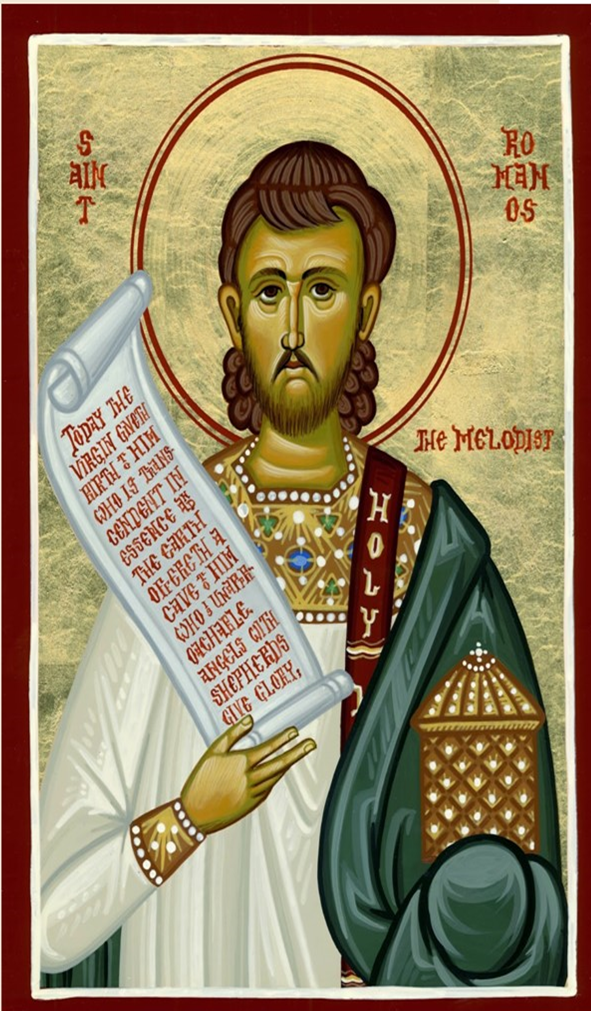HYMNOGRAPHY

From her earliest centuries, the Christian Church has used iconography and HYMNOGRAPHY much the same. Bothe are artistic media bound within the frames of dogma that communicate a sacred curriculum to the faithful by engaging two of the five senses, allowing the eyes to see and the ears to hear. HYMNOGRAPHRS are interpreters of Scripture and bearers of tradition, using their artistic skill to convey that tradition to fullness of the Church in a form that is memorable and compelling. Ultimately, writers of hymns and painters of icons communicate what they have seen or heard of the Triune God in a revelatory moment, bearing in mind the place for which the artistic expressions are destined-divine services and the house of worship. Hymnography and iconography teach humanity abiut God's plan for His Creation and our return to Eden. When speaking of Orthodox hymnography, St. Gregory palamas concludes, "All who are attuned to sacred songs and study their meaning from beginning to end will find themselves approaching God." If singing, studying and listening to sacred songs has the ability to move us closer to God as St. Gregory in fact suggests, then we are extremely blessed as nearly three-quarter of Orthodox worship consists of hymns! St. John Chrysostom unites the songs of the earth, that is the Church, with the song of the heavens: "Above, the hosts of angels sing praise; below men form choirs in the churches and imitate them by singing the same doxology. Above, the seraphim cry out in the thrice-holy hymn; below, the human throng sends up the same cry. The inhabitants of heaven and earth are brought together in a common assembly; there is one thanksgiving, one shout of delight, one joyful chorus." Christians owe a special debt of gratitude to the two Syrian masters of chant: Saint Ephraim the Syrian (306-373 AD) and Saint Romanos the Melodist (490-556 AD).
LE CHANT BYZANTIN
Le CHANT BYZANTIN est le chant liturgique traditionnel de l'Église orthodoxe, historiquement développé en langue grecque, puis en arabe (ou syriaque). Au cours des derniers siècles, le répertoire en usage a été adapté aux diverses langues des peuples orthodoxes, conduisant ainsi au développement de traditions parallèles. Chanter des hymnes divines dans sa propre langue est un désir pour tous les chrétiens, pour que la Parole soit «tout près de vous». Le chant byzantin est interprété sans accompagnement d'instrument (chant «a capella»); c'est un chant à une seule voix (monodique); une grande liberté est laissée à l'interprète pour improviser et orner les mélodies. Il peut être accompagné toutefois par le chant d'une note tenue ou bourdon (appelé «isson») qui correspond d'une certaine façon au fond d'or des icônes - symbole d'éternité. L'origine du l'Empire romain; mais c'est surtout à partir de 313 après Jésus-Christ (quand l'Église sort des catacombes) que le chant liturgique commence à se développer. Le nombre des fidèles augmentant, le chant tient une place plus importante dans les célébrations et s' enrichit au fil des siècles de nouvelles hymnes et de nouvelles mélodies plus ornées, conduisant au développement d'une HYMNOGRAPHIE et d'une tradition de chant sacré du plus haut niveau, transmise de génération en génération jusqu'à nos jours. Les premiers hymnographes furent parmi les saints hièrarques de l'Église, théologiens et poètes mystiques. Ihs écrivaient en grec- langue de culture de l'époque - et en arabe ou syriaque. Au début de VIe siècle, d'importantes innovations dans l'hymographie sont introduites par Romans, le plus célèbre des mélodes.